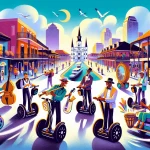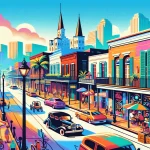Winding through the center of New Orleans, the Rampart Street Streetcar Line offers a distinctive and immersive experience for both locals and visitors. This historic transportation route, operational since 1835, has become integral to the city’s cultural identity, connecting diverse neighborhoods and providing a glimpse into New Orleans’ rich history and present.
In This Article
TL;DR
- The Rampart Street Streetcar Line connects iconic neighborhoods and districts, offering a nostalgic and authentic New Orleans experience.
- The line showcases architectural gems, cultural attractions, and lively local businesses along its route.
- The streetcar line has played a crucial role in shaping the city’s urban landscape, fostering economic growth, and promoting sustainable transportation.
Historical Context of the Rampart Street Streetcar Line
The origins of the Rampart Street Streetcar Line trace back to the early 19th century when horse-drawn carriages first traversed New Orleans‘ streets. As the city expanded and transportation needs evolved, the line transitioned to electric streetcars in the late 1800s, becoming a vital link between the bustling French Quarter and the rapidly developing neighborhoods along Rampart Street and St. Claude Avenue.
Throughout its storied history, the streetcar line has played a pivotal role in shaping New Orleans’ urban landscape. Its presence facilitated the growth of residential areas and commercial districts, allowing the city to expand outward from its historic core. Iconic events, such as the famous New Orleans streetcar strike of 1929, have also left an indelible mark on the line’s legacy.
Detailed Route Analysis and Key Stops
French Quarter and Canal Street
The Rampart Street Streetcar Line begins its journey at the intersection of Canal Street and Rampart Street, a bustling hub in downtown New Orleans. From there, it winds through the vibrant French Quarter, offering glimpses of iconic landmarks like Jackson Square and the St. Louis Cathedral.
Treme and St. Louis Cemetery No. 1
As the streetcar continues along Rampart Street, riders can disembark at stops near the historic St. Louis Cemetery No. 1, where the tomb of the legendary Voodoo Queen Marie Laveau resides. Further along, the line passes through the Treme neighborhood, a cultural hotbed known for its rich musical heritage and annual festivals.
Marigny, Bywater, and St. Claude Arts District
Continuing its journey, the streetcar traverses the Marigny and Bywater districts, where riders can explore a thriving arts scene, eclectic boutiques, and trendy eateries. The final stop on the line is at Elysian Fields Avenue, a gateway to the vibrant St. Claude Arts District and the iconic St. Roch Market.
Throughout the route, the Rampart Street Streetcar Line seamlessly connects with other public transportation options, including buses and the iconic St. Charles Avenue Streetcar Line, ensuring easy access to all corners of the city.
Architectural Highlights Along the Streetcar Line
One of the most captivating aspects of the Rampart Street Streetcar Line is the architectural diversity on display along its route. From the iconic wrought-iron balconies and colorful shotgun houses of the French Quarter to the stately mansions lining St. Charles Avenue, the streetcar offers a visual feast of architectural styles.
Riders can marvel at the grandeur of the Gallier House, a stunning Greek Revival mansion that now serves as a museum, or admire the intricate details of the Beauregard-Keyes House, a prime example of the city’s distinctive Creole architecture. The line also passes by the Cabildo, a historic Spanish colonial building that once served as the seat of government for the Louisiana Territory.
Beyond the historic structures, the streetcar route also showcases examples of modern architectural marvels, such as the sleek and contemporary Ogden Museum of Southern Art, which houses an impressive collection of works by artists from the American South.
Cultural and Artistic Significance
The Rampart Street Streetcar Line is more than just a mode of transportation; it is a living canvas that celebrates New Orleans’ vibrant cultural and artistic heritage. Along the route, riders can witness the city’s rich street art scene, with colorful murals and thought-provoking installations adorning the walls of buildings and alleyways.
Local artists have left their mark on the streetcar line, with public sculptures and installations dotting the landscape. One notable example is the “Treme Dancers” sculpture, which pays homage to the neighborhood’s rich cultural traditions and serves as a gathering point for community events and celebrations.
The streetcar line also intersects with various cultural festivals and events throughout the year, such as the French Quarter Festival and the Frenchmen Street Art Market, providing easy access for visitors and locals alike to immerse themselves in the city’s vibrant arts and music scenes.
Economic Impact of the Streetcar Line
The Rampart Street Streetcar Line has played a pivotal role in supporting the local economy and fostering tourism in New Orleans. Businesses along the route have thrived due to the steady stream of foot traffic and increased accessibility provided by the streetcar.
Iconic establishments like the Napoleon House, a historic bar and restaurant in the French Quarter, have benefited from their proximity to the line, attracting both locals and visitors seeking an authentic New Orleans experience. Similarly, the St. Roch Market, a bustling food hall in the St. Claude Arts District, has become a popular destination for foodies and tourists alike, thanks in part to its convenient location along the streetcar route.
Address: 500 St Louis St, New Orleans, LA 70130
Phone: (504) 524-9752
Address: 2381 St Claude Ave, New Orleans, LA 70117
Phone: (504) 518-2929
The economic impact of the Rampart Street Streetcar Line extends beyond individual businesses. The line has contributed to the revitalization of entire neighborhoods, attracting new investment and development while preserving the city’s unique character and charm.
Environmental and Social Benefits
In addition to its cultural and economic significance, the Rampart Street Streetcar Line also offers environmental and social benefits to New Orleans. As a form of public transportation, the streetcar reduces the number of vehicles on the road, thereby lowering emissions and promoting a more sustainable urban environment.
The line’s accessibility also plays a crucial role in promoting social equity and mobility within the city. By providing an affordable and reliable mode of transportation, the streetcar line connects residents from diverse socioeconomic backgrounds to employment opportunities, healthcare facilities, and educational institutions.
Furthermore, the streetcar’s presence has fostered a sense of community and pride among New Orleanians. The line serves as a shared experience, bringing together people from all walks of life and fostering a deeper appreciation for the city’s rich cultural heritage.
Future Prospects and Planned Developments
As New Orleans continues to evolve, the Rampart Street Streetcar Line remains a vital component of the city’s transportation infrastructure. City planners and public transit authorities have proposed several initiatives to enhance and expand the line’s services.
One such proposal involves extending the line further into the St. Claude Arts District, providing improved access to this burgeoning cultural hub and supporting the growth of local businesses and artistic endeavors. Additionally, plans are underway to upgrade the streetcar fleet with modern, energy-efficient vehicles while preserving the line’s historic charm.
These developments aim to not only improve the overall experience for riders but also to promote sustainable urban mobility and support the city’s continued growth and development. By investing in the Rampart Street Streetcar Line, New Orleans is ensuring that this iconic transportation route remains a cherished part of the city’s fabric for generations to come.






